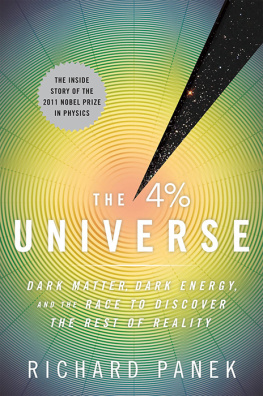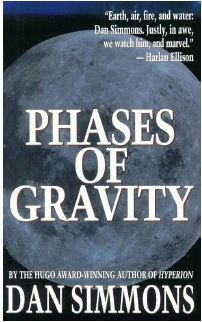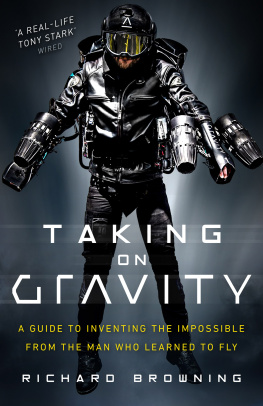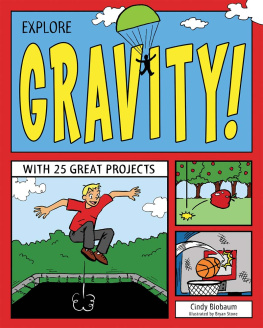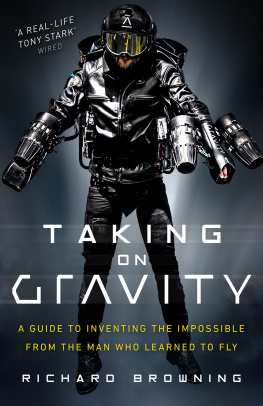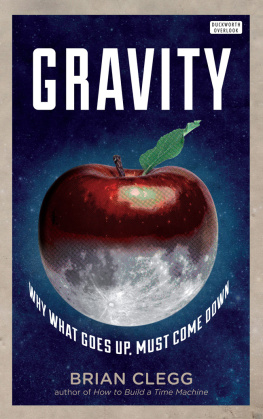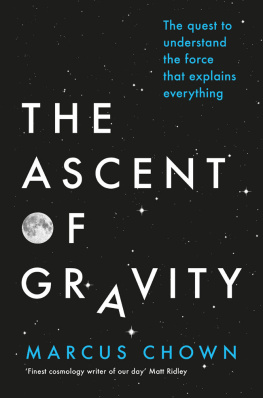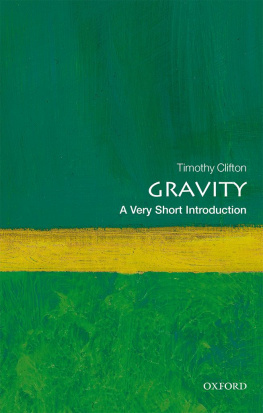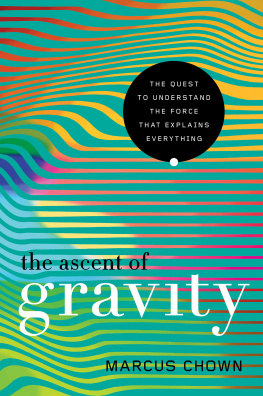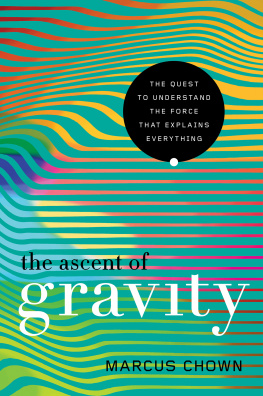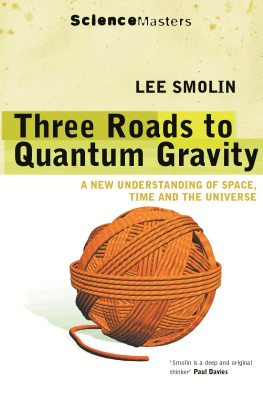Copyright 2019 by Richard Panek
All rights reserved
For information about permission to reproduce selections from this book, write to or to Permissions, Houghton Mifflin Harcourt Publishing Company, 3 Park Avenue, 19th Floor, New York, New York 10016.
hmhbooks.com
Library of Congress Cataloging-in-Publication Data
Names: Panek, Richard, author.
Title: The trouble with gravity : solving the mystery beneath our feet / Richard Panek.
Description: Boston ; New York : Houghton Mifflin Harcourt, [2019] | Includes bibliographical references and index.
Identifiers: LCCN 2018057178 (print) | LCCN 2019009530 (ebook) | ISBN 9780544568297 (ebook) | ISBN 9780544526747 (hardcover)
Subjects: LCSH : Gravity.
Classification: LCC QB 331 (ebook) | LCC QB 331 . P 35 2019 (print) | DDC 531/.14dc23
LC record available at https://lccn.loc.gov/2018057178
Lyrics from Big Science by Laurie Anderson, 1982 Difficult Music. Reprinted with permission.
Author photograph Chip Cooper
Cover design by Martha Kennedy
v1.0619
Also by Richard Panek
The 4 Percent Universe: Dark Matter, Dark Energy, and the Race to Discover the Rest of Reality
The Invisible Century: Einstein, Freud, and the Search for Hidden Universes
Seeing and Believing: How the Telescope Opened Our Eyes and Minds to the Heavens
Waterloo Diamonds: A Midwestern Town and its Minor League Team
By Temple Grandin and
Richard Panek
The Autistic Brain: Helping Different Kinds of Minds Succeed
As ever, for Meg, with love
You know, I think we should put some mountains here
Otherwise, what are the characters going to fall off of?
And what about stairs?
Laurie Anderson
Gravity:
An Introduction
I fell.
I had been sitting in a chair for a quarter of an hour, killing time in a bookstore. I had selected from a nearby shelf a book that I thought might relate to the subject I was researching at the momentI no longer recall what. Id pushed my chair away from a communal table, crossed my legs, and opened the book to a random page. The section I turned to happened to be on gravity.
What I had thought about gravity before I sat down was what most people think about gravity, to the extent that most people think about gravity: Its a force of nature. What I learned in the next few minutes is that its not necessarily a force. Isaac Newton thought of gravity less as a force than as something mysterious that acts across space. Albert Einstein thought of gravity less as a force than as something mysterious that belongsto space. And quantum physicists agree with both Newton and Einstein: Gravity is something.
I looked up from the book.
Is gravity, I wondered, just a word? A semantic convenience? A placeholder until a better noun comes along? Something that, until we know more about it, weve agreed to call the single cause of a universe full of effects?
At the time I didnt understand the nuances of these questions. Yet even Isomeone who had experienced little curiosity about science until well into adulthood; who had cultivated a professional interest in science but had only a minimal educational background in it; who in fact had taken AP math courses in high school specifically to escape having to take science courses in college (a strategy that pretty much worked)could tell that I had no idea what gravity is.
I gently closed the book and stood upbut not quite. My left foot, the one that had been resting flat on the floor for a quarter of an hour, was asleep. I am nearly six-six; I dont drop gently. My fall silenced the customers in my vicinity. Yet even as I righted myself, trying to hold on to the edge of the tabletop as well as my dignity, I realized that I had received a valuable reminder: You take gravity for granted at your own peril. I also recognized that I had discovered a new mission in lifethe pursuit of an answer to a question Id never thought to ask:
What is gravity?
What is gravity?
I was on the phone with one of the visionaries behind an experiment that had recently validated a prediction Albert Einstein had ventured almost exactly a century earlier: Gravity makes waves. Like a pebble in a pond, a gravitational interaction of any kind sends ripples, only instead of disturbing water it distorts space. Not just through the waves emitted by a collision of two black holes, which is what this experiment had detected. The fact that gravitational waves exist on that scale means that gravitational waves exist on every scale, including the human. Raise your arm: gravitational waves. Shake your head: gravitational waves. Fall over in a bookstore: gravitational waves, only bigger, Id like to believe. The announcement of the gravitational-wave detection, on February 15, 2016, was the kind of once-in-a-generation scientific event that you can accurately describe as having captured worldwide attention: headlines saturating newspapers, TV news, and the Internet; discussions dominating their subsidiary forumsletters to the editor, talking heads, comment threads, and email, including a message from an astrophysicist friend of mine that read, in its entirety, Hellzapoppin. Of whom better than Kip S. Thorne, a theoretical physicist who had been studying gravitation since the 1960s, who had co-envisioned the experiment in the 1970s, who had been helping to guide the project since the 1980sand one of the key members of the team soon to run the table in world-class physics prizes: Special Breakthrough, Gruber, Shaw, Kavli, and, in 2017, Nobelto ask what gravity is?
Thats a meaningless question, Thorne said.
Good enough. You can learn a lot from meaningless questions. Heres one that cosmologists often get: What came before the Big Bang? One answer: Thats like asking whats north of the North Pole. From that precise point, there is no north on the surface of the Earth. Theres just the surface of the Earth, extending only south.
Meaningless questions help scientists understand whats wrong with the premises behind the questionsthe unthinking assumptions that render the questions meaningless. In the case of What came before the Big Bang?, the common unthinking assumption is that space and time exist independently of the universe, an assumption that even physicists held until quite recently in the history of our species. Instead, cosmologists say, space came into existence in the Big Bang, all balled up, and the unballing-up we measure by what we call time.
What is gravity?, however, is not a question that scientists often get, primarily because non-scientists have no reason to even conceive of it. What is gravity? was probably not a question that Kip Thorne should have gotten from me, not because I hadnt conceived of it, but because I already knew the answer.
Twelve or fourteen years had passed since Id fallen over in a bookstore. The pursuit I had begun that dayto discover what gravity ishad ended almost immediately, perhaps as soon as the next day, maybe even that same evening. It required only cursory research, a minutes worth of clicks on a keyboard. The answer: Nobody knows.
For a while I had initiated many conversations on the subject with a kind of converts zeal. These conversations tended to fall into one of two categories.
Category One:
ME: Nobody knows what gravity is.
CIVILIAN: (Pause.) What do you mean, nobody knows what gravity is?
ME: I mean that nobody knows what gravity actually


